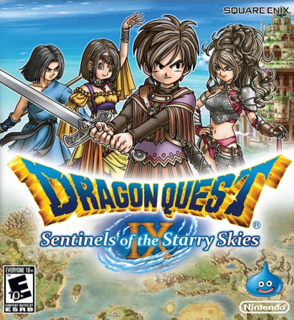Angelic fruit makes you toot
Dragon Quest IX exists to be the best portable role playing game ever made. You can feel it in every pore of its being. From the story quest that brings the player to continents and cities undiscovered, to the intense and practically infinite post-story content, the design echoes the game's purpose: to last. In many ways, it succeeds, and in a few it trips, but in the end it becomes largely what it set out to accomplish.
Dragon Quest IX started out as an online-focused game, with an action battle system and vast multiplayer capabilities. While this gave way to the standard turn based system the series is known for (due to the predictable player outrage) the game still betrays its in-development heritage with excellent improvements to the Dragon Quest formula. Additions such as local (not internet-based) multiplayer, numerous optional quests (organized by a simple menu system), higher-level randomized dungeons, achievements, weapons and armor that appear on player models, and above all, the ability to see monsters on the field as opposed to the random triggered encounters of the past. These small changes make the ever-powerful Dragon Quest framework feel even more solid.
Where the game stalls is in the speed of the battles that, while not as slow as the molasses in Dragon Quest VIII on the PlayStation 2, still manage to get tiresome. Without an option to turn off the animations, the game's barely PlayStation 1 level polygonal blobs whack at each other with far too many pauses, animations, and graphical flourishes. Sure, the game looks excellent for the DS, but considering the game's pick-up-and-play system and even design, making the battles as slow as they are is kind of an odd choice.
However, the overall pace of the game is still speedier than most RPG's, and at times it feels like Chrono Trigger's breakneck flight. Small stories pepper the landscape of Dragon Quest IX's world, each with a multi-level cave or tower and a boss fight to accompany it. These are acceptable stories told with simplicity and short, well-shot scenes, never overstaying their welcome or overdoing it with too much melodrama or exposition. Additionally, the quests tend to be of a non-linear sort, barely giving the player the location of said target. While the predictability sets in early, it's well designed and open enough that it never becomes routine.
Love it or hate it, Dragon Quest IX's overarching story is piecemeal and thin. I happen to love it: the themes are established and then touched on briefly, and the player is left to their own devices. Due to the nature of the plot – angel guardians helping villagers to save their world – the sub-stories tie into the main plot much more smoothly than in past series' attempts. This makes the main story seem less important, which in the course of a long handheld role playing game is definitely a good thing.
No, the game's only other major flaw is the slowdown, which shows that while the game is fantastic for a DS game, it is finding a bit of a roadblock here or there. Sure, some of the vistas and landscapes are simply beautiful for any system due to excellent art management. But the decision to have your entire four-person party travel on practically every scrap of land you explores means that the polygon limit for the engine is reaches quickly, mostly in busy towns. The game can slow down to twenty frames per second or less, which is barely acceptable even by Nintendo 64 standards.
But ignoring these flaws, the game accomplishes everything it sets out to do, with more content at-launch than any other portable RPG known to date. The main quest offers a nice relaxing pace at about thirty hours of adventure, but the post-game content is vast and challenging. Hundreds of hours of content await the Dragon Quest fan. Seeing how long the newest installment is taking to be released, perhaps they are simply making sure everyone has enough time to finish. It's baffling how much content is crammed into a single DS cart. And besides that, extra quests and items can be downloaded through the DS Wi-Fi service, though you're not really missing much if the service ever goes down or you don't have the capability.
What's truly clear is just how well these improvements help the franchise. These tweaks and revisions seem like scraps of modern game design finally trickling down to the dinosaur, but it's the implementation that's key here. It's so well executed and so friendly to even the most jaded of role playing players that it's hard not to agree: it really does make for a heck of a portable adventure.

